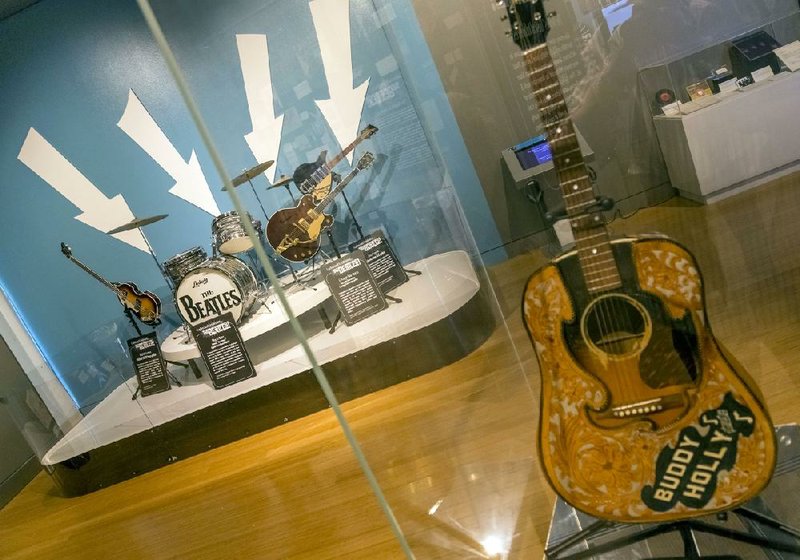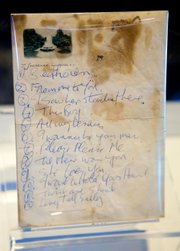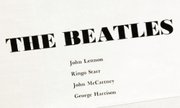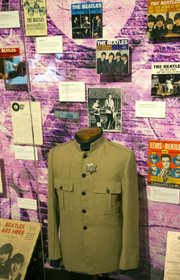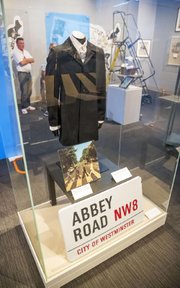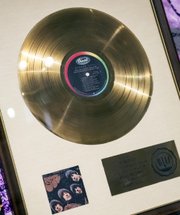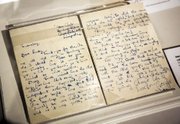There are places I remember
All my life, though some have changed
“Ladies and Gentlemen … The Beatles!”
9 a.m.-5 p.m. Monday-Saturday and 1-5 p.m. Sunday through April 2, Clinton Presidential Center, 1200 President Clinton Ave., Little Rock
Admission: $10; $8 for ages 62 and older, college students with ID and retired U.S. military; $6 for ages 6-17; free for children younger than 6 and active U.S. military.
(501) 374-4242
Some forever, not for better
Some have gone and some remain
All these places have their moments
-- "In My Life" The Beatles
In February 1964, our somber nation, still reeling from the November 1963 assassination of President John F. Kennedy, was invaded. Not by communists but by the British.
Instead of arriving for battle as their forefathers had, these four mop-topped, 20-something Liverpool lads came in rockin' and played a role in a cultural revolution fueled by music.
Soon on a first-name basis with America, John, Paul, George and Ringo made quite the first impression.
Beatlemania swept the 50 states. And we were forever changed.
"Ladies and Gentlemen ... The Beatles!" an interactive, artifact-driven traveling exhibit examining the phenomenon opened at the Clinton Presidential Center on Oct. 8 and runs through April 2.
"It's really a look at the touring years," says Ben Thielemier, communications manager with the Clinton Foundation.
The exhibit of more than 400 items, including records, rare photos, instruments, clothing and tour artifacts, was curated by the Los Angeles-based Grammy Museum and Fab Four Exhibits LLC. This is the last stop of the exhibit that celebrates the 50th anniversary of The Beatles' arrival in this country and their three North American tours in 1964, 1965, and 1966. (The traveling exhibit premiered in 2014.) It also touches on their early years in England from 1960 to 1963 and their post-touring years, 1967-1970.
"It's just a really great exhibit and topic that made sense for us to have it here," Thielemier says.
Bob Santelli, executive director of the Grammy Museum in Los Angeles, says he wanted to curate the exhibit for personal as well as professional reasons.
"I'm a big Beatles fan," says the 64-year-old New Jersey native. "I grew up listening to them, saw them on the Ed Sullivan Show as a boy, and it kind of changed my life as it did for many in my generation. As a music historian, I felt it was very important that the 50th anniversary of the arrival of The Beatles in America was something we could teach people about and those who'd been through it could recollect just how important that event actually was."
The more difficult decision? Narrowing down the more than 4,000 items offered by the collectors to about 400.
"First, you decide what the story is and then the point of view of the story," Santelli says. "Then it becomes like a jigsaw puzzle and we start to put it together to try to tell the story."
The story, as Santelli (previously vice-president of education and public programs with the Rock and Roll Hall of Fame in Cleveland) explains: "We wanted to show that The Beatles changed America and changed the way we thought. Not just what we thought about music but also about fashion, cultural ideas, religion, art, so many things."
"The 1960s was one of the most turbulent decades in our history and The Beatles provided a large part of the soundtrack for that cultural, political, and social revolution."
Interactive elements include a singalong booth where visitors can record their own version of "Yellow Submarine" and a backdrop where they can be photographed in the London crosswalk depicted on the group's Abbey Road album cover.
The Grammy Museum, which recently opened a second museum in Cleveland, Miss., has curated three previous Beatles-related exhibits -- one on John Lennon curated with Lennon's widow Yoko Ono, another on George Harrison with his widow Olivia, and a third on Ringo Starr curated with Starr.
"The only one we're missing is Sir Paul and we're still hoping to get him," Santelli says of Paul McCartney.
A DAY IN THE LIFE
The traveling Beatles exhibit premiered Feb. 6, 2014, at the New York Public Library for the Performing Arts in Lincoln Center, where it attracted 51,000 visitors. In the 2 1/2 years since, it has visited more than six U.S. cities.
As for the value of the 400 artifacts currently on display in Little Rock, Santelli says he would estimate it to be in the millions.
His favorite item is a small set list handwritten by McCartney from a Liverpool show in the early 1960s.
"That's pretty special because those things are often thrown away, especially back then," Santelli says. "One of the interesting things about their early set lists is how many American rock 'n' roll songs were on them.
"We forget that what The Beatles were doing was taking American rock 'n' roll and either being inspired by it to write their own music or reinventing it in a way in which it'd never been interpreted before and giving it back to us."
He continues, "In the early days, The Beatles were always wondering 'Why is everyone going so crazy for us? We're playing American rock 'n' roll and we're not even Americans.' Of course, what they didn't say is that they had this incredible talent and when those four parts -- those four guys -- came together, it was magic.
"No band has ever been able to reproduce that since, and 50 years later it still sounds as fresh as it ever did."
YOU REALLY GOT A HOLD ON ME
Fab Four Exhibits, created and orchestrated by four Beatles fans-turned-collectors, contributed nearly all of the items on display, and the four also served as exhibit consultants. They are considered to be among the top U.S. collectors of Beatles memorabilia.
"Those guys live in this world on a daily basis," Santelli says. "Fifty years after the fact, they're still collecting and looking for the missing pieces. I wouldn't even say it's a hobby -- it's more of a calling."
Fab Four Exhibits is made up of former outdoor advertising executive Chuck Gunderson, 54, of San Diego; Russ Lease of Columbia, Md.,(who also reproduces replicas of The Beatles' stage suits for tribute bands); Jeff Augsburger of Normal, Ill., who owns a plumbing business, specializes in collecting Beatles merchandising items and wrote The Beatles Memorabilia Price Guide; and advertising writer Mark Naboshek of Dallas, who focuses on pre-fame Beatles artifacts.
"I started collecting after I attended my first Beatlefest in Los Angeles in 1979," Gunderson says. "I started with mass-produced stuff -- bumper stickers and key chains, which was about all I could afford back then. Once I had some disposable income, I set my sights on concert memorabilia -- tickets, posters and contracts -- at first from shows around the world, then later scaled it back to focus on just the North American tours."
During the past 25 years, he has amassed what is arguably the most comprehensive collection of tour-related memorabilia and he is considered the country's leading expert on The Beatles' three North American concert tours. He's the author of the two-volume set Some Fun Tonight! The Backstage Story of How The Beatles Rocked America: The Historic Tours of 1964-1966.
After the collectors became friends they decided to become business partners, Gunderson says, adding that Augsburger, who has been collecting since 1964, probably has more than 10,000 Beatles-related items. Gunderson says he has about 200 one-of-a-kind Beatles-related items, mostly linked to the band's North American tours.
"We decided to cull our collections and try to put a traveling exhibit together," he says. "But none of us had any museum experience. We knocked on a lot of doors and after three years of trying, we finally came up with the perfect partner in the Grammy Museum."
Gunderson has one of the band's earliest 45 rpm records that was signed by all four of them.
"They only had a few formal autograph sessions in their career and this was one of them," Gunderson says of the "Love Me Do"/"P.S. I Love You" record on the Parlophone label.
"And they signed it on the 'Love Me Do' side, which is even rarer; most of the girls who went through the line wanted The Beatles to sign on the 'P.S. I Love You' side."
DO YOU WANT TO KNOW A SECRET?
Some of the stories behind the artifacts are even more interesting than the items themselves -- like the lyrics handwritten by McCartney in 1964 for a Beatles song called "What You're Doing."
"Those are extremely rare to find," Gunderson says. "A maid found it in the trash can after The Beatles left their hotel suite in Atlantic City in 1964 and it was given to Atlantic City concert promoter George Hamid Jr., who kept it for several decades before it was sold."
Also on display is the first set list, handwritten by Lennon, for the first U.S. concert, Feb. 11, 1964, in Washington.
"When you watch the film you'll see Paul take it out of his coat pocket and place it on the amp," he says. After the show ended and The Beatles left, several girls rushed the stage.
"A policeman handed the list to one girl, telling her, 'I found this on the amp; you might want it.' She was, like, 13 and hurriedly put it in her purse."
Keeping it for decades, she one day read about one of Gunderson's fellow collectors and contacted him.
"He assumed it was written by a fan; she said it wasn't," Gunderson says. "He said, 'Well can you fax it to me?' When he got it, he nearly fell on the floor; he couldn't believe it. It's a Smithsonian-quality type of thing. It's the only one known. There're not 50 of these running around."
The exhibit includes other rarities, such as concert contracts and The Beatles' clothing, including the suit jacket Ringo wore in A Hard Day's Night, one he wore in the Abbey Road album cover photo and a pair of Lennon's yellow-tinted granny glasses.
"The Hard Day's Night suit jacket came from Ringo himself," Gunderson says. "He was cleaning out his closets and auctioned this beautiful suit. It looks almost brand new. He took great care of it."
"The exhibit artifacts often getting the most attention are the merchandising items like the Beatles tennis shoes, lunch boxes and Thermos bottles," he says. "First-generation fans can relate to that because at one time they actually owned those things; they went down to Woolworths and bought them and they're seeing them again for the first time in 50 years."
EVERY LITTLE THING
When asked about his favorite exhibit item, Gunderson says, "That's virtually impossible to answer, but I'm just in love with the Shea Stadium jacket that Paul McCartney wore," he says of the Aug. 15 concert in New York, the first of the band's 1965 U.S. tour. "It's such an iconic concert, one of the few The Beatles' manager Brian Epstein allowed to be filmed. It's just so historic; it broke attendance records with 55,000 attending and ushered in stadium concerts as we know them today. And to just see that coat right there in front of you; it's just a great visual piece."
The collector says he's glad the exhibit is visiting Little Rock.
"We're really excited to be at the Clinton library and for fans to see these things that have been in our homes, in our safes, and under our beds for so long," he says with a laugh. "We just thought, 'This is ridiculous; we really should put these artifacts out where people can see them, learn from them and appreciate them.'"
Style on 10/18/2016
